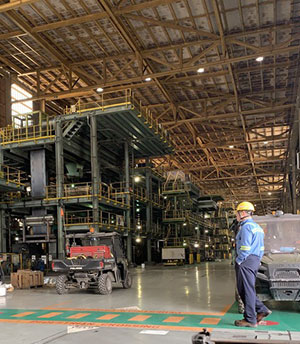AIST Foundation Steel Intern Scholarship
 Joshua P. Nelson
Joshua P. Nelson
This summer, I had the opportunity to serve as a project engineering intern at ArcelorMittal Calvert, where I independently led three major projects. The project was focused on improving operational efficiency and sustainability driving toward cost savings. These projects — “Steam Conservation and Condensate Recovery,” “Automating Chemical Dosage” and the “Batch Anneal System Productivity Performance Reporting System” — challenged me to learn about the systems they operate in but also learn how explore, propose and develop solutions. These projects reflect my commitment to learning while applying industrial engineering principles to real-world challenges in the steel industry.
Steam Conservation and Condensate Recovery
 I created a 52-page report that represents a comprehensive analysis of ArcelorMittal Calvert’s steam infrastructure with a detailed solution centered around minimizing loss. I identified key inefficiencies in steam and condensate loss, developed a multifaceted solution, and conducted a detailed financial analysis, intentionally focusing on providing a financial system analysis to justify the project cost in support of internal approval. I concluded with a project foundation with a projected internal rate of return of 157% and a year one return on investment of 58.86%.
I created a 52-page report that represents a comprehensive analysis of ArcelorMittal Calvert’s steam infrastructure with a detailed solution centered around minimizing loss. I identified key inefficiencies in steam and condensate loss, developed a multifaceted solution, and conducted a detailed financial analysis, intentionally focusing on providing a financial system analysis to justify the project cost in support of internal approval. I concluded with a project foundation with a projected internal rate of return of 157% and a year one return on investment of 58.86%.
The project included a plan to utilize new combustion control systems to reduce natural gas usage in the industrial boilers. In addition, a detailed drip trap survey was conducted for replacement summary, and finally a proposed condensate loop. The plan factored in engineering, materials, and labor cost in collaboration with vendors like TLV, Hargrove, and MetalWorks. Furthermore, the plan identified stalling heat exchanger traps and proposed system improvements to integrate into existing infrastructure. Additionally, the plan determined infrastructure, financial benefit and electrical feasibility of an automatic analog valve to control steam to a frequently unused steam line.
Despite limited data availability, I employed creative problem-solving — leveraging MATLAB, field surveys and vendor consultations — to build a robust financial model. This project also deepened my understanding of boiler control systems, a critical area of knowledge in industrial energy management. My new experience in water treatment, steam systems and process productivity measures will be valuable wherever I go.
Overall, the creative freedom and opportunities to assemble a detailed solution while staying financially focused was not only valuable but truly enjoyable.
Automating Chemical Dosage
This project focused on optimizing chemical usage in wastewater treatment. By automating chemical dosage based on pH levels, I proposed a system that could reduce chemical waste, improve emulsion breaking efficiency and implement with workforce flow. The financial model projected significant cost savings and operational consistency. Construction and installation were underway throughout the end of my internship.
Batch Anneal System Productivity Performance Reporting System
This project involved designing a system to collect and categorize delay and shaft data in the annealing process. The goal was to quantify productivity losses and develop performance metrics that could guide future improvements. This work laid the foundation for a predictive model to assess the impact of specific delays on throughput.
Furthermore, operational productivity was modeled using a discrete-event framework, where each annealing turn was treated as unit operation with associating delay state and throughput metrics. The model incorporates time-based performance indicators, including delay categorization, process base performance and turn completion rates. Calculating the system’s capacity of the equipment involved defining the theoretical maximum throughput under ideal conditions.
In addition, the model quantifies the impact of delays and inefficiencies through a loss function. This approach enabled the derivation of performance metrics such as process availability, ideal charge conditions and impact to productivity, which are used to benchmark and visualize operational efficiency.
Reflection and Forward Commitment
As a rising junior in industrial engineering at Penn State, an AIST Foundation Scholar, and a member of the Material & Manufacturing Group (MMG), I’ve always been passionate about applying data-driven methods to reduce waste and improve systems. These projects allowed me to do just that, while also sharpening my skills in cost analysis, vendor coordination and technical communication.
While I’m proud of the progress made, I recognize that these initiatives are just the beginning. I’ve documented each project thoroughly to ensure continuity, and I remain committed to supporting their implementation even after my internship concludes.
